One of our more unique and impressive genera of flowering plants is the beautifully dainty and eye-catching Billy Buttons. These perennial herbaceous specimens often form as small shrubs that feature golden yellow small globe-shaped flowers atop long and sturdy stems and a narrow rosette of leaves.
Each plant can produce up to 200 daisy-like golden globe flowers which can quickly add an unparalleled appeal to any outdoor space, regardless of setting. Here is your guide to growing and caring for Billy buttons.
More...
Family: | Asteraceae |
|---|---|
Genus: | Craspedia |
Species: | C. globosa |
New Name: | Pycnosorus globosus |
Common Names: | Billy buttons, drumsticks |
Location: | Outdoor |
Type: | Perennial herbs, small shrubs |
Growth: | 0.5 to 1 metre tall, 0.1 to 0.3 metres wide |
Sun requirements: | Full sun to light shade |
Foliage Colour: | Green |
Flower Colour: | Golden yellow |
Flowering: | Spring to summer |
Maintenance level: | Low |
Poisonous for pets: | Non-toxic to cats and dogs |
Another excellent benefit to establishing this plant is that it flowers for a long time and will look stunning every time. In hot climates, it will flower year-round, constantly showing off its spherical golden blooms.
The long-stemmed flowers also look fantastic in fresh or dried floral arrangements which can be used to spruce up your indoor spaces as well. Enjoy their playfully dainty influence in your garden along with low-maintenance growing requirements.
Getting to Know the Billy Buttons
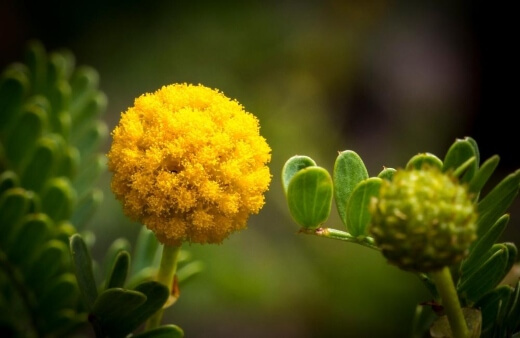
Previously named Craspedia globosa, the plant has now been renamed as Pycnosorus globosus where common names include Billy buttons and drumsticks.
The genus consists of 6 species of plants in the Asteraceae family, all native to Australia where they occur in all states except Tasmania.
Being very adaptable to our endemic conditions, these plants thrive in warm temperate, cool temperate, Mediterranean, cool and hot climates. In hot climates, they will bloom year-round.
Pycnosorus globosus Growing Habits
In gardens, Pycnosorus will grow at a moderate rate to roughly 0.5 to 1 metre tall and 0.1 to 0.3 metres wide. This small shrub can be used in a few positions within landscapes, commonly grown as a feature plant, border specimen, wow-factor, or attractive gap filling in beds.
They will seamlessly integrate themselves into flower gardens, cottage-style gardens, native gardens and even coastal gardens. (For more on coastal gardening, refer to our guide here).
6 Australian Pycnosorus Species
Golden Billy Buttons (Pycnosorus chrysanthus)
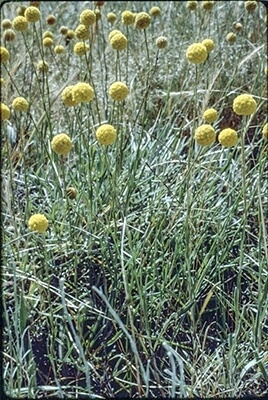
Source: apps.lucidcentral.org
Known as golden billy buttons or yellow drumsticks, this species features pale yellow globular flowers with golden hues. Its stems are woodier and can reach 60cm tall.
It occurs largely in New South Wales and South Australia, being a protected species in New South Wales. The leaves differ from other species as they have three distinctive longitudinal veins. Flowering is also between spring and summer.
Pycnosorus eremaeus
There, unfortunately, isn’t much information available for this species but it largely occurs in Queensland, Northern Territory and South Australia. It is a smaller growing species that also produces the golden-yellow blooms we’ve come to know.
Its form is often narrower and reaching than the common billy buttons with flowers that can also grow with a more oval shape than perfectly spherical.
Pycnosorus globosus
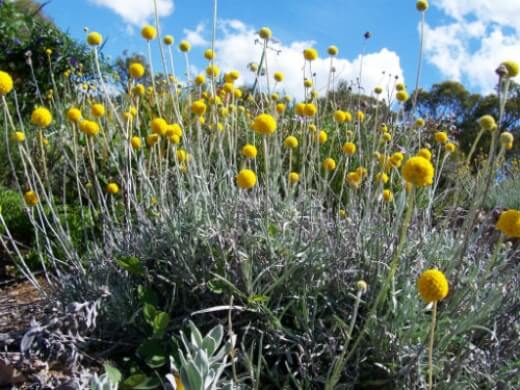
Source: resources.austplants.com.au
This is the most widely distributed and cultivated species. The flowers shine with brighter tones of yellow and gold, growing in an almost perfect dainty sphere.
Its foliage sports a silvery-grey colour that sits below the golden globe flowers on tall and stout green stems. The blooms are commonly seen in fresh and dried floral arrangements and this species is among the most ornamental and accessible for home gardens.
The plant will grow to around 1 metre tall and 0.5 metres wide in cultivation.
Pycnosorus melleus
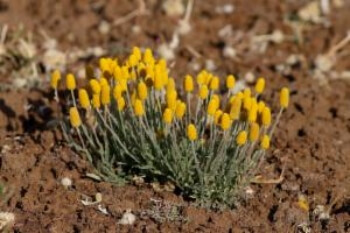
Source: bie.ala.org.au
Commonly known as round billy buttons, this species occurs in Queensland and South Australia. Its foliage is very silvery and the shrub itself only reaches about 0.2 metres tall, commonly growing in a neat and compact round shape.
The golden-yellow flowers tend to form in a more oval shape that stand upright atop the small silver leaves. Its form is oftentimes more spreading than the other species in the genus.
Soft Billy Buttons (Pycnosorus pleiocephalus)
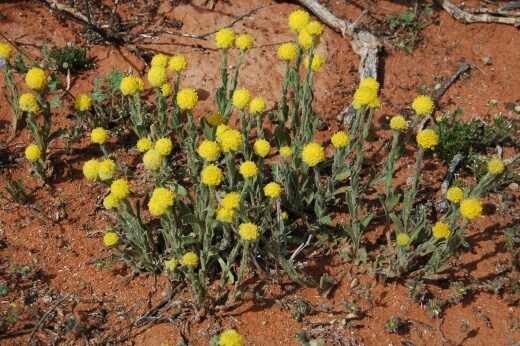
Source: vicflora.rbg.vic.gov.au
Known as soft billy buttons, these upright and ascending annuals feature fluffier golden-yellow flowers and grow up to 40cm tall. It produces many stems with long and narrow hairy leaves that form upwards with the flowers.
The leaves differ from the other species as they feature a single prominent longitudinal vein. The flowers often age with a deeper golden tone.
Pycnosorus thompsonianus
Another species that features woodier stems and a tighter upright form. The stems can reach up to 35cm tall, branching slightly at the base of the plant.
The foliage is light-grey and woolly with more fine hairs. The flowers are smaller but still have that golden-yellow colour we’ve come to love. This species occurs largely in New South Wales.
How to Grow Billy Buttons
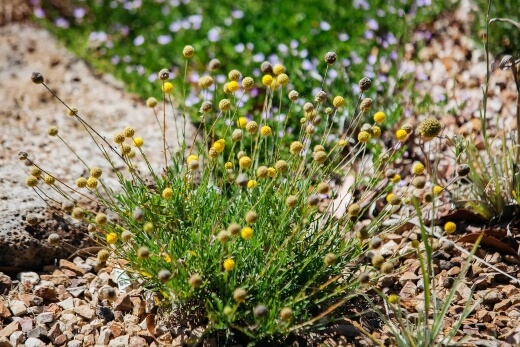
Source: nativeplantproject.com.au
The easiest way to grow billy buttons is from seeds that germinate readily within only a few weeks. Sow your seeds in spring or summer for the best results.
Prepare your bed by slightly loosening the surface soil, optionally enriching the soil with some organic compost. Then simply sprinkle your billy button seeds onto the soil. Seeds should be sown at a depth of 2 to 3 millimetres.
Lightly rake to cover the seeds then water gently. Germination should occur within 14 to 21 days. Once your seedlings are big and healthy enough to transfer, dig small planting holes that are twice as wide and to the same depth as the root ball of the young seedlings.
Place the seedlings in your holes at a plant spacing of about 20 to 30 centimetres. You can expect the first flowering within only 12 weeks and shortly thereafter, flowers should be ready for harvesting.
Related Post: Sowing Seeds vs Planting Seedlings – Which is Better?
Ideal Conditions for Planting Billy Buttons
Craspedia doesn’t normally require much fuss at all. They are known as low-maintenance additions to gardens so getting the basics right will quickly ensure you’ve got bountiful billy buttons in your landscape.
Plant in spring, summer or autumn for the best results.
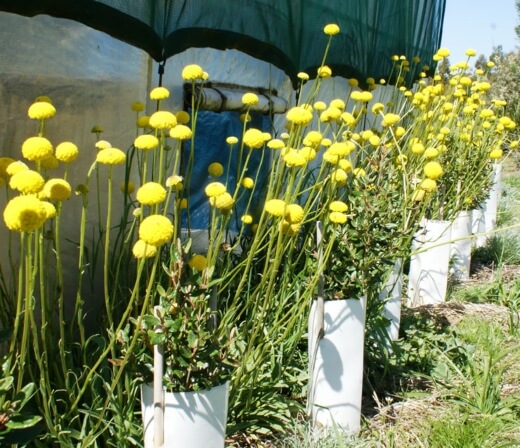
Source: victoriannativeseed.com.au
Best Soil for Billy Buttons
The soil must be moist and well-draining for these small shrubs to thrive. Apart from that, they are pretty adaptable to soil types. The preferred soil is sandy loam but the plant can also grow in loamy or clay-loam soils provided the soil is well-draining.
Billy buttons don’t enjoy acidic soils so a neutral soil pH is best. (Soil pH Meter Test Kits available here).
Lighting Needs
These sun-loving plants will thrive in full sun to lightly shaded positions. Your plant should get at least 6 hours of direct sun to bloom best. Choose a location in your landscape that gets plenty of sunlight and you’ll have beautifully blooming shrubs in no time.
Temperature & Humidity for Billy Buttons
While the plant is in dormancy during the colder periods of the year, it shouldn’t struggle as long as extended exposure to heavy frost is avoided.
General garden humidity should be great but they do tend to prefer drier conditions overall. The plants will be able to tolerate temperatures down to around -6°C.
Billy Buttons Plant Care Tips
Once established, Craspedia globosa will be very tolerant to occasional frosts as well as short periods of drought. If your plant dies off, it will be able to resprout when its active season draws nearer.
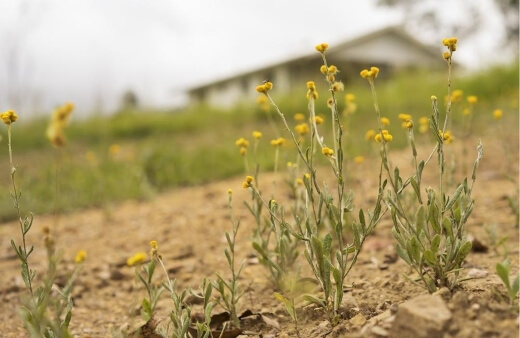
Here are the basic care instructions for the Pycnosorus plants.
How to Water Billy Buttons
Being a drought-tolerant native, this plant actually won’t require much water to grow well. Water your plant only when the top layer of soil has become dry to the touch.
Best Fertiliser for Craspedia Globosa
Feeding your billy buttons can boost their growth, especially when fed in its active growing season. Fertilise with a quality slow-release fertiliser during spring and summer.
For a healthy soil pH, try to use a 7-12-7 fertiliser for the best results. When fertilising, you can also add some compost or well-rotted manure for an extra boost. Water lightly after feeding.
Pruning Billy Buttons
You will need to lightly tidy up your plant after flowering at the end of summer by removing old flower stems when they begin to look drab. Your plant should remain neat with tidy leaf clumps until new flower stems form next year.
Learn the ins and outs of pruning Australian native plants here.
Mulching Needs
These plants love warm conditions. Adding a layer of mulch around the planting site in summer will help to regulate temperatures and suppress weeds.
It is recommended to use a layer of mostly gravel with some large bark chips. The stones will massively help with regulating the plant's temperature as conditions cool.
Drying Billy Buttons
The cut flowers look fantastic in fresh or dried bouquets, adding a unique touch to your décor indoors. To preserve your billy buttons’ flowers, simply cut them and hang them upside-down to allow them to fully dry out.
They will retain their beauty as they dry. Hang them in a warm, dark and dry location. Once dried, you can get creative and add them to any cut flower arrangements.
Pycnosorus Globosus Pest & Disease Control
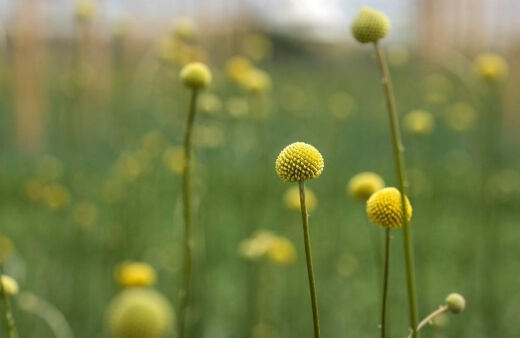
Pycnosorus plants are hardy and rarely struggle with any disease issues. Pests can become a problem in certain conditions. Bees and butterflies will naturally be attracted to the stunning flowers but pests like snails, slugs and spider mites are certainly unwanted as they can cause damage if left unchecked.
Snails and slugs will usually feast on the plant overnight so be sure to keep an eye out for any signs of them. They can be manually removed and disposed of off-site but in severe cases, hiring professionals to get rid of infestations might be the better option.
For spider mites, you can use a mixture of water and soap to spray and knock them off the plant. Alternatively, using an organic insecticide or neem oil spray are also excellent alternatives to treatment.
Billy Buttons Frequently Asked Questions
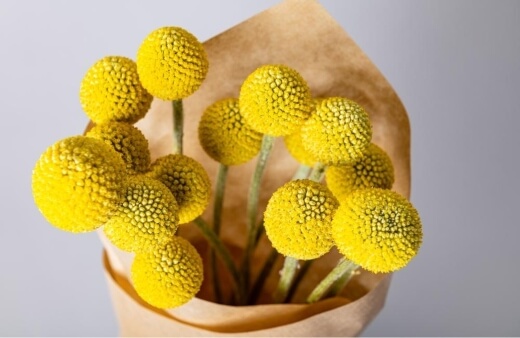
How long do billy button plants last?
These perennials will grow for more than 2 years and are considered long-lasting.
Do billy buttons spread?
These plants aren’t known as vigorous spreaders. They do best in dry and hot conditions where they may spread a little more than usual. In general, they are not considered invasive and shouldn’t spread within cultivated landscapes.
Are billy buttons poisonous?
Known to be non-toxic to humans and pets. They can cause mild toxicity in sheep, cattle and horses.
Interested in establishing other fantastic native flowers in your garden? Be sure to refer to our informative grow guide below for more information:
Boost Your Gardens Buoyancy with the Beautifully Bulbous Billy Buttons
A truly unique flowering genus of Australian natives, billy buttons are the perfect pick for any grower looking for a stunning native flowering plant or anyone interested in using the cut flowers for floral arrangements.
With their playfully buoyant influence within landscapes and easy-going natures, these plants really are for any setting and cater to any grower regardless of experience.
Perfectly suited to most of our endemic conditions, billy buttons are a must-have addition to flower gardens, cottage-style gardens, native gardens and coastal gardens.
Published on December 13, 2023 by Gary Clarke
Last Updated on February 25, 2024




